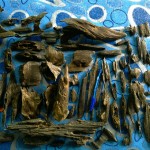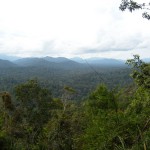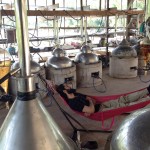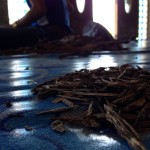Wild Oud: State of Affairs

Today, things aren’t the same as they were only a couple years ago. Or a decade ago, or 3 decades ago. And the direction in which the world of oud seems to be headed doesn’t seem too bright.
Although wild agarwood has been steadily dwindling since the mid-1900’s, it wasn’t until around 2006 or so when everything changed. The demand of Chinese collectors for the highest grades of agarwood – the type that only come from ancient trees – exploded to mythic proportions. Prices doubled, tripled and ten-folded in a matter of a handful of years. The demand is only increasing, but the trees are getting scarcer and scarcer. This is the time to act fast; I still haven’t recovered from all the travelling and yet I am already planning my next trip in a few months, possibly to Indonesia this time.

There are plenty of agarwood trees in many jungles across South-East Asia, have no doubt about that. But they are more difficult to get to. And is the quality still the same as, say, wood of the same grade from a decade ago? Now that’s the real question.

In West Malaysia, the Orang Asli (Malay for ‘original man’) are the backbone of gaharu hunting activities. They are the aboriginal dwellers of the jungles, and certainly “the sire of the house knows best its contents”. The structure that I set up in Malaysia consists of Cambodian Khmer, Malay, and Orang Asli hunters. While they all have their fair share of experience in the jungles, the Orang Asli are without a doubt the peerless champs. The jungle is their home; they love it, live it, and don’t want to leave it. The only technology they seem to love is cell phones. An old toothless Orang Alsi grandma using the latest iPhone is a sight to behold!

Masters of the jungle they may be, but they are very superstitious and what’s interesting to note is that what the Chinese bigwigs refer to as Good Luck Wood (the finest grades of agarwood), the Orang Asli view as being the source of bad luck.

For every hunting expedition where King Super grade wood is found, they complain that something horrible happens to one of the hunting party members. Although I do not believe in bad luck, omens, and superstition, I still find it thought-provoking that one Orang Asli hunter went missing in this very excursion that brought me my King Super chunks pictured above (still no news about him, hope he’s okay!).
In the last hunting trip that Yusof participated in where King Super grade wood was found, he tells me that one of his friends, a fellow hunter, was stung to death by a swarm of bees.

What’s my opinion? I believe that as the really ancient trees that contain King Super grade agarwood are disappearing from more accessible areas, the hunters are having to penetrate deeper and deeper into uncharted territories. The environment itself is more treacherous. Its more difficult to find drinkable water, the animals are not accustomed to seeing humans, and the sheer population of dangerous animals is much denser. There’s a famous jungle near the Kelantan-Pahang border where allegedly everything is gigantic. Massive elephants, tigers, super-sized man-eating flowers and king-sized cockroaches. So aside from the ‘gross!’ factor, the environmental threats increase significantly as you delve deeper into the jungles.

As for finding A-grade and super-grade wood, then there’s still plenty left in Malaysia (and even more in Indonesia). But these grades themselves are not what they were a decade ago. Super grade from 2004 would now be considered high-end Double Super. Also, its harder to get them now, than it was a decade ago.

Perhaps the question on the minds of many of you is: what about the quality of oils today? Can we get oils today that would compare in quality to oils distilled 10-20 years ago. Things get a little complicated here.
One thing we all know is that the higher the quality of wood that’s used, the higher will be the quality of the oil. But just as the case is today, distillers have typically resorted to using bunk wood for distilling oil and reserving higher grades of wood to sell in wood form. This is the key factor that distinguishes AgarAura incense-grade oils (and true incense-grade oils from other sellers) from your standard, run of the mill oud oils. Other factors include mastering the art of distillation, and of course the issue of purity (most oud oils in the market are spiked and stretched with adulterants, to meet the volume of demand).
But high grade distillations have existed for a long time, particularly for oils that are produced for members of Arab royal families. In fact, the use of sinking-grade agarwood (or “underwater wood” and “sink wood” as it used to be called before) was common for these clients. In Malaysia, these oils were called “Minyak Super”.

This, of course, was and is the exception and not the norm. The norm is to use white bunk-wood which doesn’t have much (or any) agarwood oleoresin, and this you can easily obtain for very cheap. Almost 5 years ago, I first used the term ‘incense grade’ to describe higher quality raw materials for producing oil. But what is ‘incense grade’ wood? And can ‘incense-grade’ oils compare in quality to incense-grade oils distilled decades ago?

When I say ‘incense grade’, I refer to wood that is fit for burning. But even incense grade wood comes in various grades. On one end of the incense grade spectrum would be cheap cultivated Thai wood. On the opposite end is King Super agarwood and kinam. Are the two alike? Of course not. Will the oil extracted from the two be alike? Most certainly not!

The simplest way to ensure high quality for an oil would be to use king super grade wood. It may be the easiest, but its certainly not the wisest. Aside from the scarcity of this grade of wood in this day and age, there’s also the law of diminishing returns. Up to a certain point, increasing the quality of the wood used for distillation will increase the quality of the oil’s aroma and also increase the yield (let’s call this the yellow stage). After that point, the quality of the aroma will continue to improve but the yield will start declining (let’s call this the green stage). Beyond that, you will hit a point where the quality of the oil’s aroma will remain the same even if you increase the quality of the raw material, and the yield will also be much lower (let’s call this the red stage). This is due to the higher concentration of resin in the wood, and a lesser amount of oil. And aside from the fact the resin portion of agarwood oleoresin never gets extracted during distillation, the resin actually blocks oil from getting extracted.
The optimal range to work within is the green stage. You can still get very beautiful yelow stage oud oils (our Ponlamai Thai would be a classic example), if you do the distillation right. But to get oils that are unparalleled in richness and depth, you have no choice but to operate in the green and red stages. And you have to ensure that the oleoresin is not just years but decades old.
So why not just distill red stage oils? For starters, not everyone is willing to pay $2,000+ for a bottle of oil. Furthermore, if you can achieve exactly the same aroma (identical in smell, richness, and depth) by carefully crafting green stage oils, then its in the best interest of the distiller as well as the buyer to deal with this grade. Because you get the absolute best aroma possible, and at the most affordable price possible.
Of course collecting raw materials for ‘green stage’ oils, and ensuring it qualifies as that, is a nightmare. Its a painstaking and time-consuming process. The gaharu team will spend countless hours carving high grade chunks of agarwood, and the debris collected has to be further sifted to ensure the best wood is selected for distillation. Moreover, the debris collected from carving king super wood will be superior to the debris collected from super grade wood – even if that super grade wood falls within sinking-grade. In short: its a complicated and time-consuming process, but the end result is an oud oil with the finest, richest, and deepest aroma possible (and without sending you to the poor house). That, in my opinion, is what AgarAura customers seek. And this is the foundational principle of AgarAura’s “smart distillation” philosophy.
Awesome wood and very informative article Taha. That is some beautiful wood and oil. I sure hope the Orang Asli are able to keep and take care of their home forest while still benefiting from the demand of agarwood.
Well done job taha
Thanks a lot for the information, i’ll be eagerly waiting for the relaunch of the online store ,may Allah bless your work and good deeds